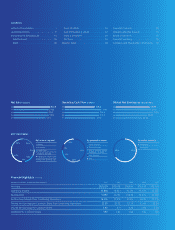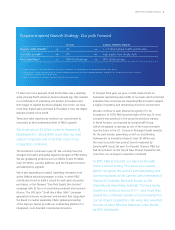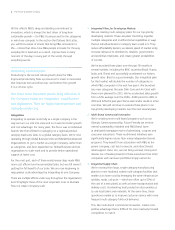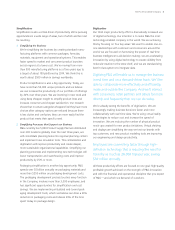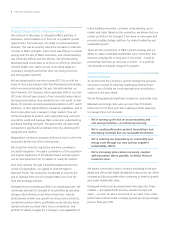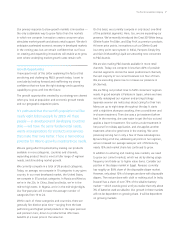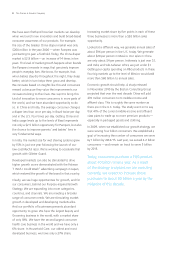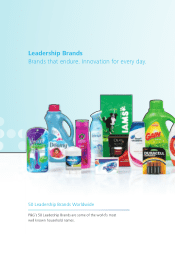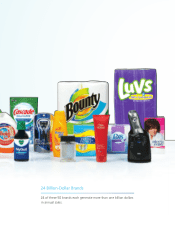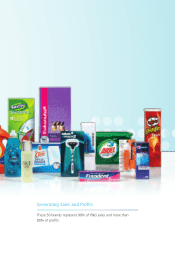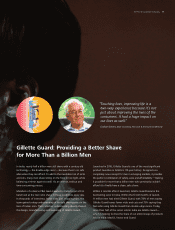Proctor and Gamble 2011 Annual Report Download - page 10
Download and view the complete annual report
Please find page 10 of the 2011 Proctor and Gamble annual report below. You can navigate through the pages in the report by either clicking on the pages listed below, or by using the keyword search tool below to find specific information within the annual report.We have seen firsthand how fast markets can develop
when we launch new innovation and build broad-based
consumer awareness of our products. For example,
the size of the Greater China diaper market was only
$200million in the year 2000—when Pampers was
just starting to gain a foothold. Today, the China diaper
market is $2.8billion—an increase of 14 times in ten
years. This level of market growth happens when brands
like Pampers innovate in ways that genuinely improve
people’s everyday lives. We know, for example, that
when babies stay dry throughout the night, they sleep
better, which in turn helps them grow and develop.
We innovate based on insights like this and consumers
reward us because they value the improvements our
innovations bring to their lives. We want to bring this
kind of innovation to more consumers in more parts of
the world, and we have abundant opportunity to do
so. In China and India, the average consumer changes
a diaper less than once per day, in Brazil twice per day
and in the U.S. four times per day. Getting China and
India usage levels up to the levels of Brazil represents
not only a $2.5billion opportunity for Pampers, but also
the chance to improve parents’ and babies’ lives in
very fundamental ways.
In India, the market size for wet shaving systems grew
by 15% in just one year following the launch of our
low-cost Mach3razor. We’re working to accelerate that
growth with Gillette Guard.
Developed markets can also be stimulated to drive
higher growth as we demonstrated with the Febreze
“IWish I Could Wash” advertising campaign in Japan,
which restored the growth of the brand in that country.
Clearly, we see huge opportunities for growth, and for
our consumers, behind our Purpose-inspired Growth
Strategy. We are expanding into more categories,
countries, and channels. We are meeting a broader
range of consumer needs. We are stimulating market
growth in developed and developing markets alike.
And our portfolio of businesses presents abundant
opportunity to grow. We have the largest Beauty and
Grooming business in the world, with a market share
of only 18%. We have the second largest consumer
health care business in the world and we have only a
6% share. In Household Care, our oldest and most
developed business, we have only a 27% share.
Increasing market share by five points in each of these
three businesses is more than a $20 billion sales
opportunity.
Looked at a different way, we generate annual sales of
about $96 per person in the U.S. today. We generate
about $20 per person in Mexico. Our sales in China
are only about $4per person. Indonesia is just over $1,
and India and Sub-Saharan Africa are just under $1.
Getting per capita spending on P&G products in these
four big markets up to the level of Mexico would add
more than $60 billion to annual sales.
Economic growth should help. A study released
in November 2010 by the Boston Consulting Group
projected that over the next decade China will add
270 million consumers to its middle-income and
affluent class. This is roughly the same number as
there are in the U.S. today. The study went on to say
that 41% of the current middle-income and affluent
class plans to trade up to more premium products —
especially in packaged goods and clothing.
Today, consumers purchase a P&G product
about 40 billion times a year. As a result
of the strategy and plans we are executing
currently, we expect to increase those
purchases to about60 billion a year by the
midpoint of this decade.
8The Procter & Gamble Company
In , when we established our growth strategy, we
were serving four billion consumers. We established a
goal of increasing the number of consumers we serve
by 1billion by /. Last year, we served .billion
consumers —and remain on track to serve billion
by.


